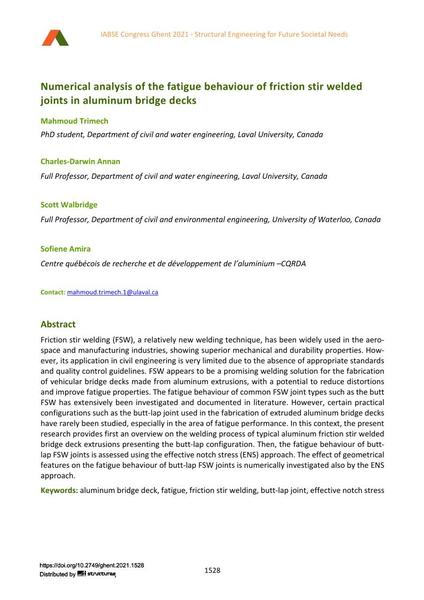Numerical analysis of the fatigue behaviour of friction stir welded joints in aluminum bridge decks

|
|
|||||||||||
Détails bibliographiques
| Auteur(s): |
Mahmoud Trimech
(PhD student, Department of civil and water engineering, Laval University, Canada)
Charles-Darwin Annan (Full Professor, Department of civil and water engineering, Laval University, Canada) Scott Walbridge (Full Professor, Department of civil and environmental engineering, University of Waterloo, Canada) Sofiene Amira (Centre québécois de recherche et de développement de l’aluminium –CQRDA) |
||||
|---|---|---|---|---|---|
| Médium: | papier de conférence | ||||
| Langue(s): | anglais | ||||
| Conférence: | IABSE Congress: Structural Engineering for Future Societal Needs, Ghent, Belgium, 22-24 September 2021 | ||||
| Publié dans: | IABSE Congress Ghent 2021 | ||||
|
|||||
| Page(s): | 1528-1536 | ||||
| Nombre total de pages (du PDF): | 9 | ||||
| DOI: | 10.2749/ghent.2021.1528 | ||||
| Abstrait: |
Friction stir welding (FSW), a relatively new welding technique, has been widely used in the aero- space and manufacturing industries, showing superior mechanical and durability properties. How- ever, its application in civil engineering is very limited due to the absence of appropriate standards and quality control guidelines. FSW appears to be a promising welding solution for the fabrication of vehicular bridge decks made from aluminum extrusions, with a potential to reduce distortions and improve fatigue properties. The fatigue behaviour of common FSW joint types such as the butt FSW has extensively been investigated and documented in literature. However, certain practical configurations such as the butt-lap joint used in the fabrication of extruded aluminum bridge decks have rarely been studied, especially in the area of fatigue performance. In this context, the present research provides first an overview on the welding process of typical aluminum friction stir welded bridge deck extrusions presenting the butt-lap configuration. Then, the fatigue behaviour of butt- lap FSW joints is assessed using the effective notch stress (ENS) approach. The effect of geometrical features on the fatigue behaviour of butt-lap FSW joints is numerically investigated also by the ENS approach. |
||||
| Copyright: | © 2021 International Association for Bridge and Structural Engineering (IABSE) | ||||
| License: | Cette oeuvre ne peut être utilisée sans la permission de l'auteur ou détenteur des droits. |
||||
